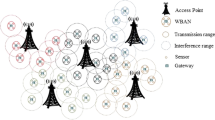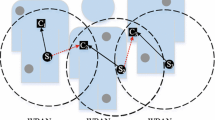Abstract
Increase in the popularity of non-invasive health monitoring systems has led to the large deployment of dedicated access points (APs) in a medical environment. Most of the existing literature assumes the wireless body area network (WBAN) association with the AP to be a nonissue but several factors can affect the medical quality of service (mQoS) requirements of the WBANs. The factors like the population associated with each AP, link quality between each WBAN and AP, and available capacity with each AP are some of them. Therefore to establish the best connectivity between each WBAN and its AP, a non-cooperative game based on a no-regret learning algorithm is proposed. A novel inter-WBAN communication model for packet transmission from each WBAN to its associated AP is also proposed. It is based on a dynamic priority scheduling in each WBAN coordinator and multi-class slotted Aloha (S-Aloha) reservation for data transmission from multiple WBAN coordinators to the APs. Simulation results show that the proposed scheme reduces the packet delays experienced by both the critical as well as the normal medical packets, when compared with two existing schemes, under different scenarios. The convergence behavior and the equilibrium efficiency of the proposed model are also validated.



Similar content being viewed by others
References
IEEE standard for local and metropolitan area networks-part 15.6: Wireless Body Area Networks (2012).
Liu, Q., Mkongwa, K. G., & Zhang, C. (2021). Performance issues in wireless body area networks for the healthcare application: A survey and future prospects. SN Applied Sciences, 3, 155. https://doi.org/10.1007/s42452-020-04058-2.
Movassaghi, S., Abolhasan, M., Lipman, J., Smith, D., & Jamalipour, A. (2014). Wireless body area networks: A survey. IEEE Communications Surveys & Tutorials, 16(3), 1658–1686.
Qu, Y., Zheng, G., Ma, H., Wang, X., Ji, B., & Wu, H. (2019). A survey of routing protocols in WBAN for healthcare applications. Sensors, 19(7), 1638.
Yap, K. L., & Chong, Y. W. (2017). Optimized access point selection with mobility prediction using hidden Markov model for wireless network. In 2017 ninth international conference on ubiquitous and future networks (ICUFN) (pp. 38–42).
Bhatia, M., & Kumar, K. (2020). Network selection in cognitive radio enabled wireless body area networks. Digital Communications and Networks, 6(1), 75–85.
Misra, S., & Sarkar, S. (2014). Priority-based time-slot allocation in wireless body area networks during medical emergency situations: An evolutionary game-theoretic perspective. IEEE Journal of Biomedical and Health Informatics, 19(2), 541–548.
Manirabona, A., Boudjit, S., & Fourati, L. C. (2016). A priority-weighted round robin scheduling strategy for a WBAN based healthcare monitoring system. In 2016 13th IEEE annual consumer communications and networking conference (CCNC) (pp. 224–229).
Yi, C., Alfa, A. S., & Cai, J. (2015). An incentive-compatible mechanism for transmission scheduling of delay-sensitive medical packets in e-health networks. IEEE Transactions on Mobile Computing, 15(10), 2424–2436.
Yi, C., & Cai, J. (2018). Transmission management of delay-sensitive medical packets in beyond wireless body area networks: A queueing game approach. IEEE Transactions on Mobile Computing, 17(9), 2209–2222.
Yi, C., & Cai, J. (2018). A truthful mechanism for scheduling delay-constrained wireless transmissions in IoT-based healthcare networks. IEEE Transactions on Wireless Communications, 18(2), 912–925.
Yi, C., & Cai, J. (2016). A priority-aware truthful mechanism for supporting multi-class delay-sensitive medical packet transmissions in e-health networks. IEEE Transactions on Mobile Computing, 16(9), 2422–2435.
Yi, C., & Cai, J. (2019). Delay-dependent priority-aware transmission scheduling for e-health networks: A mechanism design approach. IEEE Transactions on Vehicular Technology, 68(7), 6997–7010.
Xu, S., Ren, F., Xu, Y., Lin, C., & Yao, M. (2013). Selecting a preferable access point with more available bandwidth. In 2013 IEEE International Conference on Communications (ICC) (pp. 6311–6316).
Antoniou, J. (2020). Game theory, the internet of things and 5G networks. Berlin: Springer.
Mittal, K., Belding, E. M., & Suri, S. (2008). A game-theoretic analysis of wireless access point selection by mobile users. Computer Communications, 31(10), 2049–2062.
Yu, S. M., & Kim, S. L. (2014). Game-theoretic understanding of price dynamics in mobile communication services. IEEE Transactions on Wireless Communications, 13(9), 5120–5131.
Hespanha, J. P. (2017). Noncooperative game theory. Princeton: Princeton University Press.
Chen, L. (2010). A distributed access point selection algorithm based on no-regret learning for wireless access networks. In 2010 IEEE 71st vehicular technology conference.
Xu, X., & Zhao, Q. (2020). Distributed no-regret learning in multiagent systems: Challenges and recent developments. IEEE Signal Processing Magazine, 37(3), 84–91.
Han, Y. S., Deng, J., & Haas, Z. J. (2006). Analyzing multi-channel medium access control schemes with ALOHA reservation. IEEE Transactions on Wireless Communications, 5(8), 2143–2152.
Netterman, A., & Adiri, I. (1979). A dynamic priority queue with general concave priority functions. Operations Research, 27(6), 1088–1100.
Pandey, S., Shandilya, K., & Agarwal, S. (2020). Prioritized S-ALOHA for URLLC. In 2020 international wireless communications and mobile computing (IWCMC) (pp. 1842–1847).
George, E. M., & Jacob, L. (2019). Multi-class delay sensitive medical packet scheduling in inter-WBAN communication. In 2019 IEEE international conference on advanced networks and telecommunications systems (ANTS) (pp. 1–5).
Al Hanbali, A., Alvarez, E. M., & van der Heijden, M. C. (2015). Approximations for the waiting-time distribution in an M/PH/c priority queue. OR Spectrum, 37(2), 529–552.
Kim, S. (2018). Game theory for wireless ad hoc networks. In Game Theory: Breakthroughs in Research and Practice (pp. 353–368). IGI Global.
Wang, D., Comaniciu, C., Minn, H., & Al-Dhahir, N. (2008). On modeling utility for cooperative slotted aloha games. In 2008 IEEE international conference on acoustics, speech and signal processing (pp. 2761–2764).
Wang, D., Comaniciu, C., Minn, H., & Al-Dhahir, N. (2008). A game-theoretic approach for exploiting multiuser diversity in cooperative slotted aloha. IEEE Transactions on Wireless Communications, 7(11), 4215–4225.
Funding
No funds, grants, or other support was received.
Author information
Authors and Affiliations
Corresponding author
Ethics declarations
Conflict of interest
The authors declare that they have no conflict of interest.
Ethical approval
This article does not contain any studies with human participants or animals performed by any of the authors.
Additional information
Publisher's Note
Springer Nature remains neutral with regard to jurisdictional claims in published maps and institutional affiliations.
Rights and permissions
About this article
Cite this article
George, E.M., Jacob, L. Medical QoS provisioning for multi-class data in coexisting wireless body area networks. Telecommun Syst 79, 151–161 (2022). https://doi.org/10.1007/s11235-021-00857-z
Accepted:
Published:
Issue Date:
DOI: https://doi.org/10.1007/s11235-021-00857-z




